The Crucial Step Before Repaving Your Parking Lot: Post-Rain Inspection
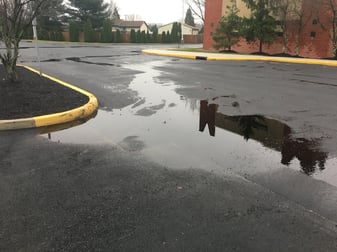
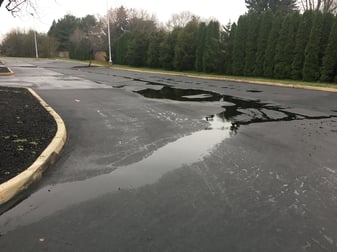
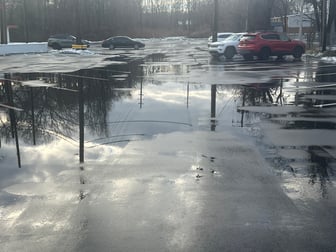
As an asphalt paving professional for over 15 years, I've witnessed firsthand the transformative power of a well-paved parking lot. Not only does it enhance the aesthetic appeal of a property, but it also significantly improves functionality and safety for vehicles and pedestrians alike. However, a crucial step often overlooked in the excitement of repaving projects is the examination of the parking lot 24 hours after a rainstorm to identify any existing drainage issues. This step is paramount to ensure the longevity and effectiveness of the new asphalt surface. In this blog post, we'll dive into the importance of this examination, the dangers of neglecting drainage issues before resurfacing, and the best practices for addressing these concerns.
There's nothing more frustrating than coming out to see puddles all over a freshly paved parking lot after the first rain storm. However, this is a very common site, but the good news is, that it can be avoided with the proper preparation if it takes place. In 15 years, I have heard countless horror stories from commercial property owners and managers about drainage issues in the parking lot after the paving and what happens when they're not addressed before the paving starts.
Who is to blame?
In my opinion, it's the paving contractor. As professionals; commercial property managers and owners are looking to them for counsel and advice on how to correct the current condition of the parking lot. Although this may not be a popular opinion among paving contractors, nevertheless I believe this is the case.
Property, managers, mistakenly, believe if there is a drainage issue that the asphalt paving contractor is going to bring it to their attention prior to resurfacing the parking lot. However, this is rarely the case and this is how most disputes begin revolving around puddles in parking lots after Paving has been completed . Most paving contractors have language inside their contracts specifically just claiming them from liability in the event there's standing water in a parking lot after paving if the grade is less than 2%. It takes a slope of at least 2% to properly drain water off of a parking lot into a swale, catch basin, riprap, basin, etc.
Unfortunately, most paving contractors take the attitude of if there was a puddle in the parking lot before milling and paving. There will be a puddle in the parking lot when they're done paving and they assume the customer understands this and agrees to this, however, this is the wrong way to start a paving project. Drainage issues are best corrected before starting a paving project or signing a paving contractor agreement.
Understanding Drainage in Asphalt Paving
Drainage is a critical component of any asphalt surface. Proper drainage ensures that water is efficiently removed from the surface, preventing it from accumulating or seeping into the substrate layers. When water is allowed to pool on the surface or penetrate the asphalt, it can lead to a myriad of problems, including potholes, cracks, and premature deterioration of the pavement.
Why Inspect After Rain?
Inspecting a parking lot 24 hours after a significant rainstorm provides a clear picture of how well the current grading is draining the water off the parking lot. This timeframe allows enough time for water to either drain away or reveal problem areas where water collects. These problem areas, often referred to as "ponding" or "standing water," are telltale signs that the existing drainage is inadequate and requires correction.
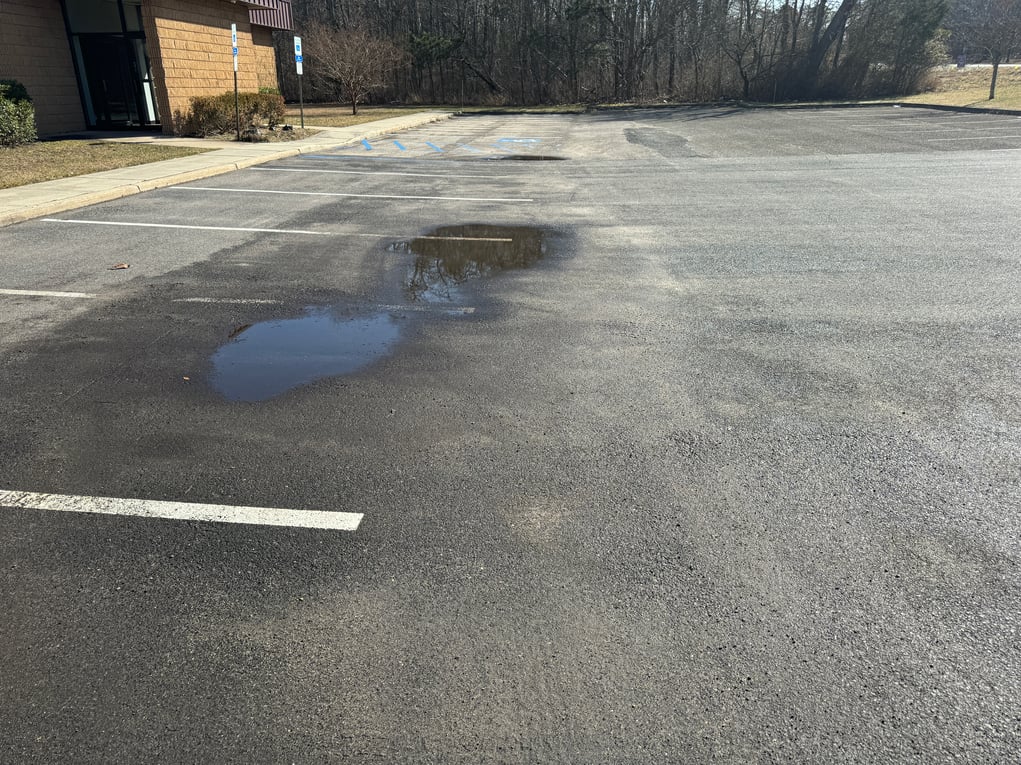
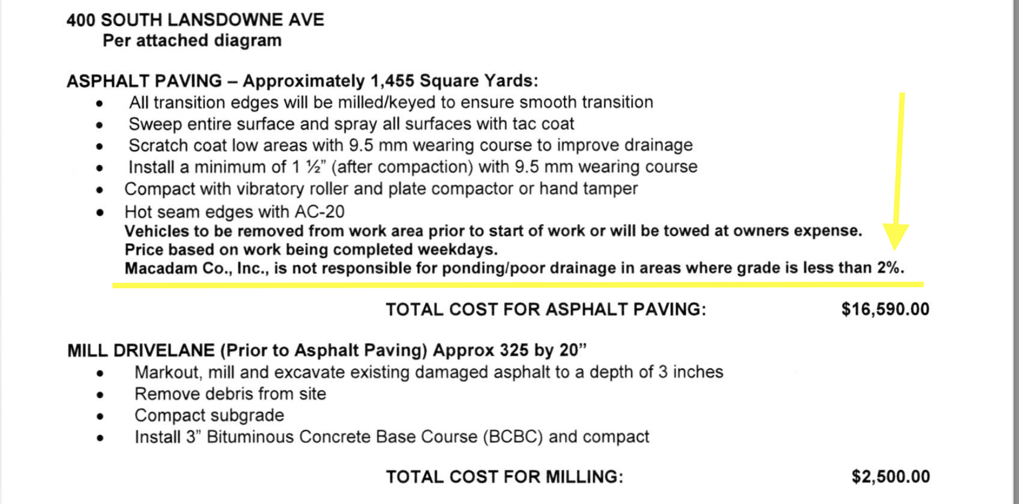
Most paving contractors will have a specific disclaimer (above) in their contract stating that a puddle is only considered a puddle if it remains in the parking lot at a depth of 1/4 inch or more 24 hours after the rain stops. Legally speaking- if you retained money from their contract or refused to pay them but signed their proposal they would prevail in Court to collect the money. As the property owner aside from having to pay in full for the entire job, plus potential legal fees and interest you're still stuck with a parking lot covered in puddles.
This is why it is imperative to seek out a paving professional who understands how to properly scope a parking lot and find potential drainage issues before milling and paving or resurfacing your asphalt parking lot.
*** This is where 90% of problems happen with asphalt paving contractors concerning drainage. The property owner/manager assumes the paving contractor has taken the proper steps to scope the parking lot for drainage issues. The paving contractor assumes the property owner/manager is not concerned if they did not discuss drainage issues before awarding the paving contract. EDUCATION AND COMMUNICATION CAN SOLVE THIS ISSUE.
The Dangers of Ignoring Drainage Issues Before Repaving
Resurfacing a parking lot without first addressing any underlying drainage issues is akin to putting a band-aid on a wound without cleaning it first. It may look better temporarily, but the underlying problems will only worsen over time. Here are some of the dangers of neglecting drainage issues before applying new asphalt:
1. Premature Pavement Failure
Water is asphalt's greatest enemy. When water is trapped beneath the surface, it can erode the foundation, leading to cracks, potholes, and eventually, a complete failure of the pavement. By resurfacing without correcting drainage problems, you're setting the stage for premature pavement failure, which can be costly and disruptive to repair.
2. Increased Liability
Pooling water creates slip-and-fall hazards for pedestrians, increasing the property owner's liability for accidents. Furthermore, water-filled potholes and uneven surfaces pose significant risks to vehicles, potentially leading to damage claims. Ensuring proper drainage before repaving reduces these risks and protects the property owner from potential legal and financial repercussions.
3. Wasted Investment
Investing in new asphalt is significant, and failing to address drainage issues can render this investment futile. The new surface may look pristine initially, but underlying water problems will quickly manifest as visible damage, necessitating further repairs or even a complete redo of the job. This not only wastes the initial investment but also incurs additional costs for corrective measures.
Best Practices for Addressing Drainage Issues
Identifying and correcting drainage issues before resurfacing is not just recommended; it's essential. Here are some best practices to ensure your parking lot's longevity and functionality:
1. Comprehensive Site Inspection
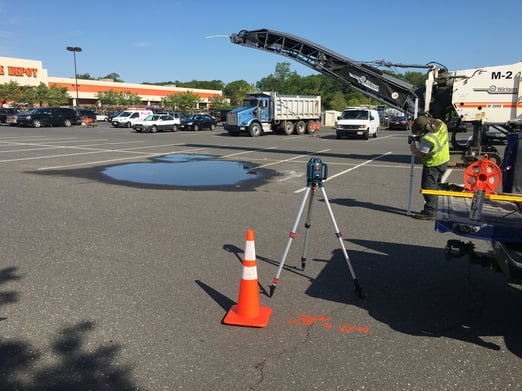
.jpg?width=556&height=291&name=map_20230906%20(2).jpg)
Conduct a thorough inspection of the parking lot, especially after rain, to identify areas of concern. Look for signs of ponding water or sections of the parking lot that are slow to drain. Once the areas are identified create a "puddle map" to have the paving superintendent use along with marking the areas with spray paint. If you are resurfacing a parking lot the painted areas are easy to see when running a leveling course to remove the puddles. When milling and paving it's imperative not to "lose track" of where the standing water is located in the parking lot. This takes teamwork between the milling operator, ground person, superintendent, and sweeper truck. Once the area is milled (taking care to not OVERMILL the location) the area needs to be swept clean and the low area painted again. After painting a leveling course of asphalt is installed and the grades re-checked to make sure the water will properly sheet flow.
2. Implement Corrective Measures
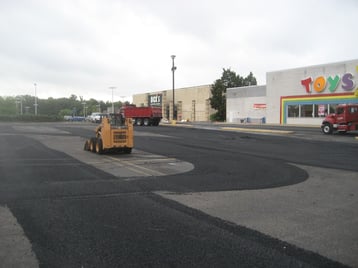
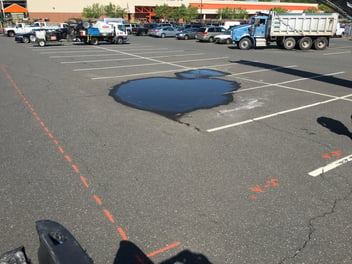
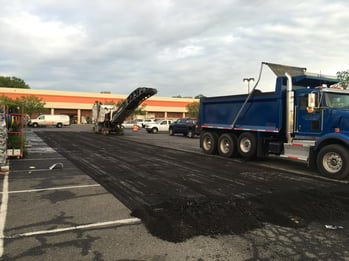
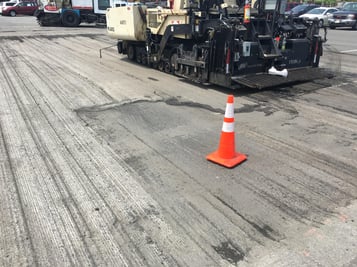
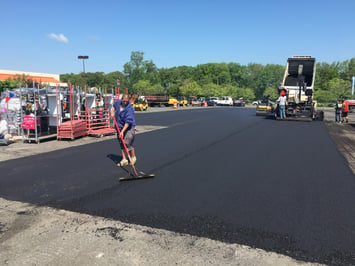
Based on the inspection findings, implement corrective measures to improve drainage. This may involve re-grading the surface to promote proper slope, installing a leveling course with asphalt to fill low sections and in some cases installing additional drains or catch basins (see below).
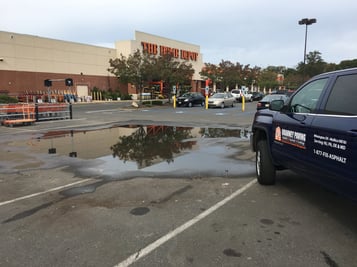
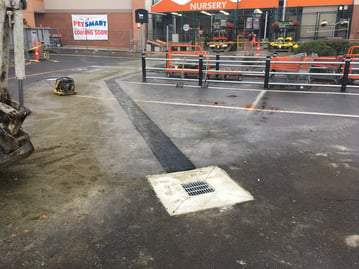
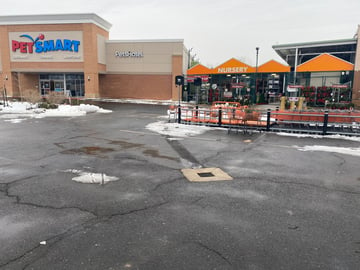
In cases where a parking lot was graded defectively from the beginning of construction; may require a remediation where a smaller catch basin is installed to remove standing water. An asphalt leveling course and milling will not always correct drainage issues if you cannot attain a cross slope or running slope of a minimum of 2%. A professional asphalt paving contractor will be able to best guide you on the proper option for your exact drainage. Correction situation.
3. Consult with Professionals
Drainage and asphalt paving are complex, and sometimes, the best course of action is to consult with professionals who have the experience and expertise to diagnose and remedy drainage issues effectively. More importantly, that professional paving contractor will be able to tell you prior to starting the project whether or not they can correct the current drainage situation.
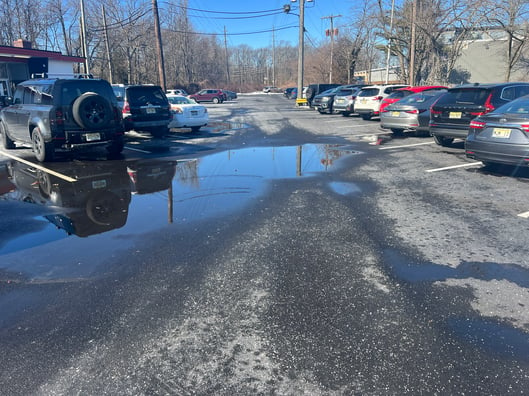
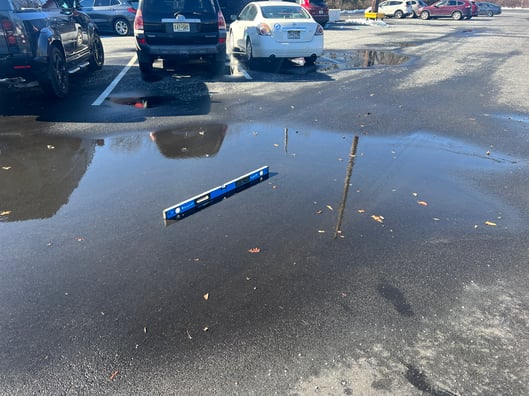
In the example above this parking lot was paved less than 30 days ago. The paving contractor did not explain to the customer that after paving there still was going to be a puddle in the parking lot for the reason that there is no cross slope or running slope to be able to properly drain the water. The entire parking lot in essence is dead level at 0%. Had the paving contractor been a drainage expert; he would have been able to discuss this with the property owner before paving the parking lot. At that point, the property owner could've elected to install two or three small catch basins in the low section of the parking lot to redirect the water and then use asphalt to grade the rest of the parking lot to get the water to drain. As it was explained to me from the owner, he had commented to the paving contractor that there were large puddles in the parking lot before the paving was completed, and the paving contractor assumed the property owner understood that, without correcting the drainage they would remain in the parking lot and after paving. As you can imagine this miscommunication left the property owner extremely dissatisfied with the paving project.
The only option at this point would be to install two small catch basins to remove the standing water. However, that would result in a patch for the utility trench being excavated through the entire brand-new parking lot. This case in itself is a perfect example of why never assume an asphalt paving contractor intends to correct any drainage issues on the parking lot unless it's agreed on in writing on the proposal before the job starts.
4. Regular Maintenance
Even after addressing drainage issues and resurfacing the parking lot, regular maintenance is key to preventing future problems. This includes keeping drains clear of debris, monitoring for signs of water damage, and conducting periodic inspections to ensure the drainage system remains effective.
Navigating Contractor Concerns: When Your Paving Contractor Won't Conduct a Drainage Test
What should you do if your paving contractor is unwilling to perform a drainage test before paving? Here, we'll explore steps you can take to navigate this situation, ensuring that your parking lot paving project is successful and durable.
Understanding the Importance of Drainage Tests
First, it's vital to understand why a drainage test is so crucial as discussed above in several examples. A drainage test after a significant rain event helps identify these potential issues, allowing for corrective measures to be taken before they're exacerbated by a new layer of asphalt.
Communicating the Value of a Drainage Test
If your contractor is hesitant, it may be due to a lack of awareness about the importance of drainage testing, concerns about project timelines, or budget constraints. Here’s how you can address these concerns:
-
Educate on the Long-Term Benefits: Share information on how proper drainage can extend the lifespan of the pavement and prevent costly repairs down the line. Highlighting the long-term savings and benefits can make a compelling argument for the value of a drainage test.
-
Discuss Potential Liabilities: Make your contractor aware of the liability issues associated with improper drainage, such as increased risk of accidents due to standing water. Understanding the legal and financial risks might prompt a reconsideration of the importance of drainage testing.
-
Offer to Share Costs: If budget concerns are the main issue, propose sharing the cost of the drainage test. This demonstrates your commitment to the project’s success and might make the contractor more willing to comply.
Exploring Alternative Solutions
If your contractor remains unwilling to perform a drainage test, consider the following alternatives:
-
Hire a Third-Party Consultant: Engage an independent civil engineer or a drainage consultant to conduct the test. Although this adds to your costs, obtaining an unbiased assessment of your parking lot’s drainage situation can provide peace of mind and actionable insights.
-
Request a Detailed Plan: Ask your contractor to provide a detailed plan on how they intend to manage potential drainage issues without a test. This plan should include slope grading, installation of drainage structures, and any warranties on workmanship to cover future drainage-related problems.
-
Consider a Different Contractor: If your current contractor is not willing to ensure the long-term success of your project by conducting essential tests, it may be time to seek quotes from other contractors who understand the importance of pre-paving drainage assessments.
Conclusion
The importance of examining a parking lot for drainage issues 24 hours after a rainstorm cannot be overstated. It is a critical step that ensures the success and durability of a new asphalt surface. Ignoring drainage problems before repaving not only jeopardizes the structural integrity of the pavement but also wastes valuable resources and increases liability risks. By adopting best practices for addressing drainage issues, property owners and paving professionals can ensure that their investment in new asphalt is protected and that the parking lot remains safe, functional, and visually appealing for years to come.
Remember, a well-planned paving project that includes a thorough post-rain inspection and corrective drainage measures is not just an asphalt investment; it's an investment in the property's future value and safety.
While facing resistance from a paving contractor over conducting a drainage test can be frustrating, it's a situation that can often be resolved through education, negotiation, or seeking alternative expertise. Remember, the goal is to protect your investment and ensure your repaved parking lot stands the test of time. Taking proactive steps to address drainage issues before paving is critical, and working with a contractor who shares this perspective is essential for the success of your project.










Leave a Comment